FRIDAY, SEPTEMBER 25
■ Yesterday evening, the Moon shone close to Jupiter. Now it's Saturn's turn to pair up with the Moon, as shown below.
All week, as the Moon steps farther east, the two giant planets continue shining nearly level in the south at dusk. They tilt to the right as evening advances. They set in the southwest around midnight.
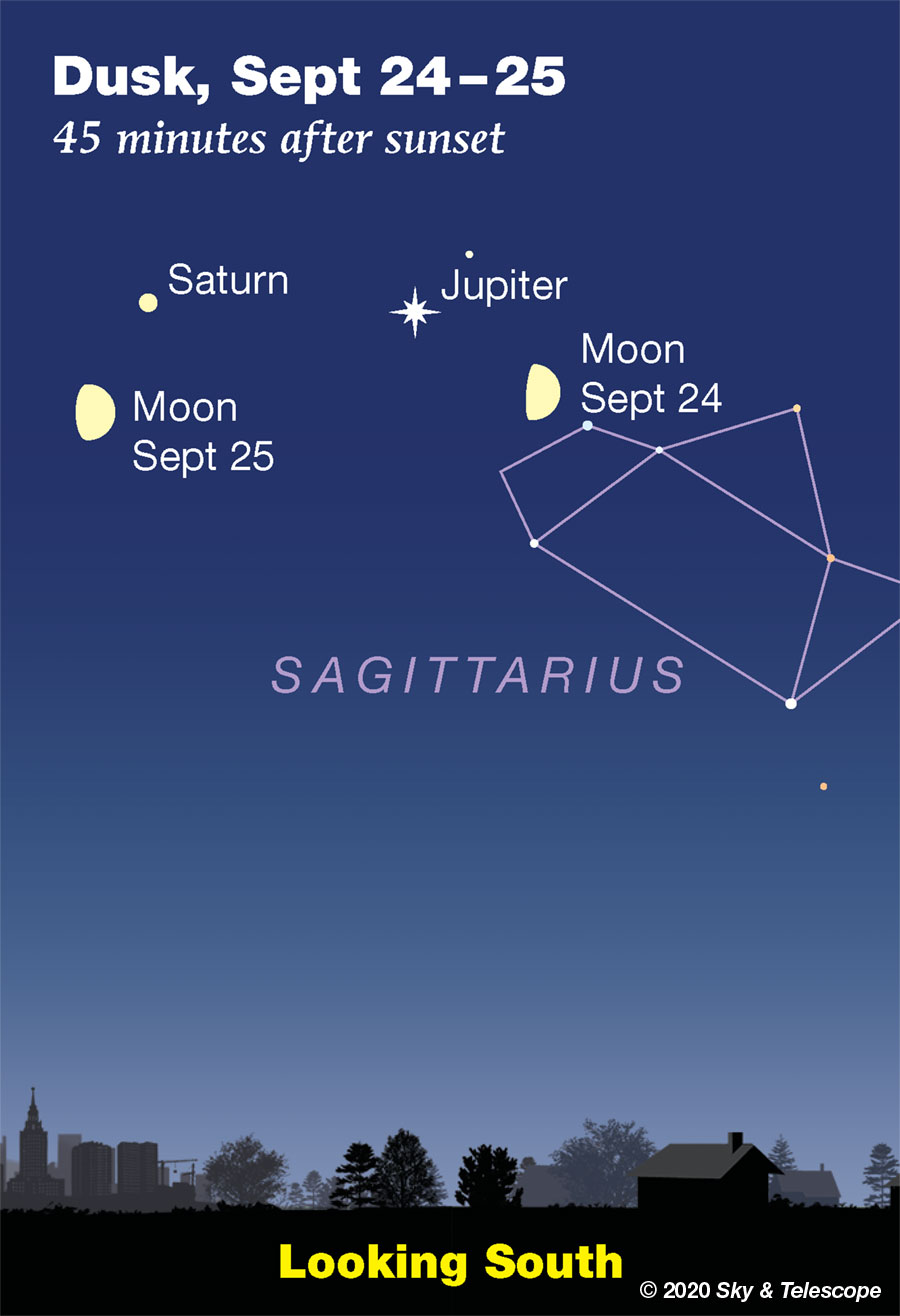
SATURDAY, SEPTEMBER 26
■ Now the waxing gibbous Moon shines inside the dim, boat-shaped star pattern of Capricornus, left of Saturn and Jupiter. Look to the Moon's lower left a little farther to spot Fomalhaut, the Autumn Star, slowly gaining altitude now that autumn is here.
SUNDAY, SEPTEMBER 27
■ Arcturus shines in the west these evenings as twilight fades out. Capella, equally bright, is barely rising in the north-northeast (depending on your latitude; the farther north you are the higher it will be.) They're both magnitude 0.
Late in the evening, Arcturus and Capella shine at the same height in their respective compass directions. When will this happen? That depends on both your latitude and longitude.
When it does, turn around and look low in the south-southeast. There will be 1st-magnitude Fomalhaut at the same height too — exactly so if you're at latitude 43° north (from Boston to Buffalo, Milwaukee, Boise, Eugene). Seen from south of that latitude, Fomalhaut will appear higher than Capella and Arcturus are. Seen from north of there, it will be lower.
■ Jupiter's Great Red Spot should transit Jupiter's central meridian around 8:32 p.m. Eastern Daylight Time. Later, at 10:41 p.m. EDT, Io will reappear out of eclipse from Jupiter's shadow. Watch for it to emerge into sunlight over a couple of minutes a little to the planet's east.
MONDAY, SEPTEMBER 28
■ Cygnus the Swan floats nearly straight overhead these evenings. Its brightest stars form the big Northern Cross. When you face southwest and crane your head up, the cross appears to stand upright. It's about two fists at arm's length tall, with Deneb as its top. Or to put it another way, when you face that direction the Swan appears to be diving straight down (which real swans never do). Trace it out through the moonlight.
TUESDAY, SEPTEMBER 29
■ Jupiter's Great Red Spot should transit Jupiter's central meridian around 10:11 p.m. EDT. An hour and ten minutes later, Io starts crossing Jupiter's face.
WEDNESDAY, SEPTEMBER 30
■ Arcturus shines ever lower in the west-northwest after dark. And far to its right, in the northwest, the Big Dipper is turning more level. Its bowl now receives the imaginary water dumped by the dim Little Dipper high above. The Big Dipper will dump it back to the little one in the evenings of spring.
THURSDAY, OCTOBER 1
■ Full Moon (exact at 5:05 p.m. EDT). Once the Moon is up low in the east in twilight, look for yellow-orange Mars to come into view roughly a fist at arm's length to its lower left. They'll appear a lot closer together tomorrow!
■ Before dawn on Friday morning, look east. Venus and Regulus are only 0.6° apart. Regulus, below or lower left of Venus, is less that a hundredth as bright.
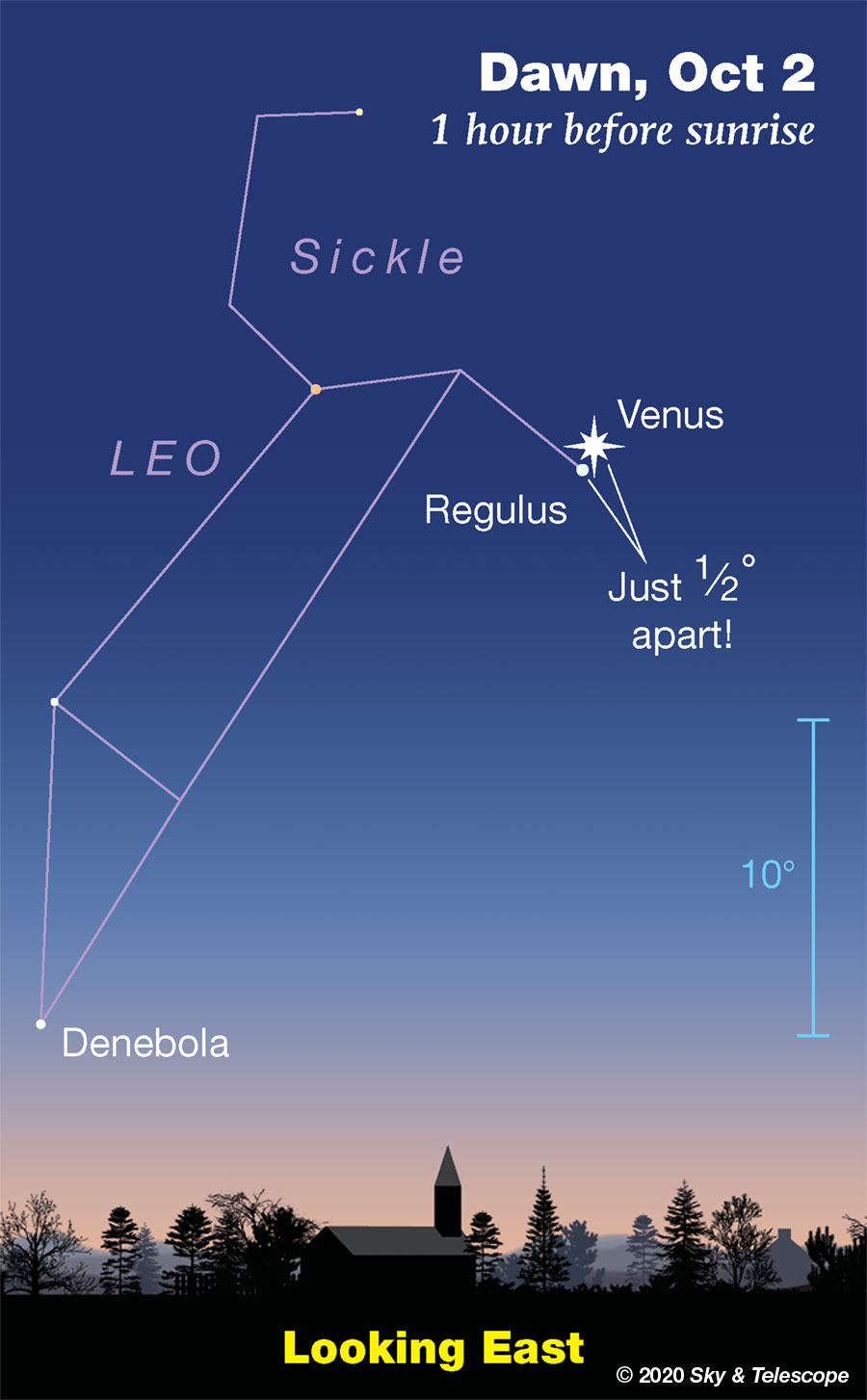
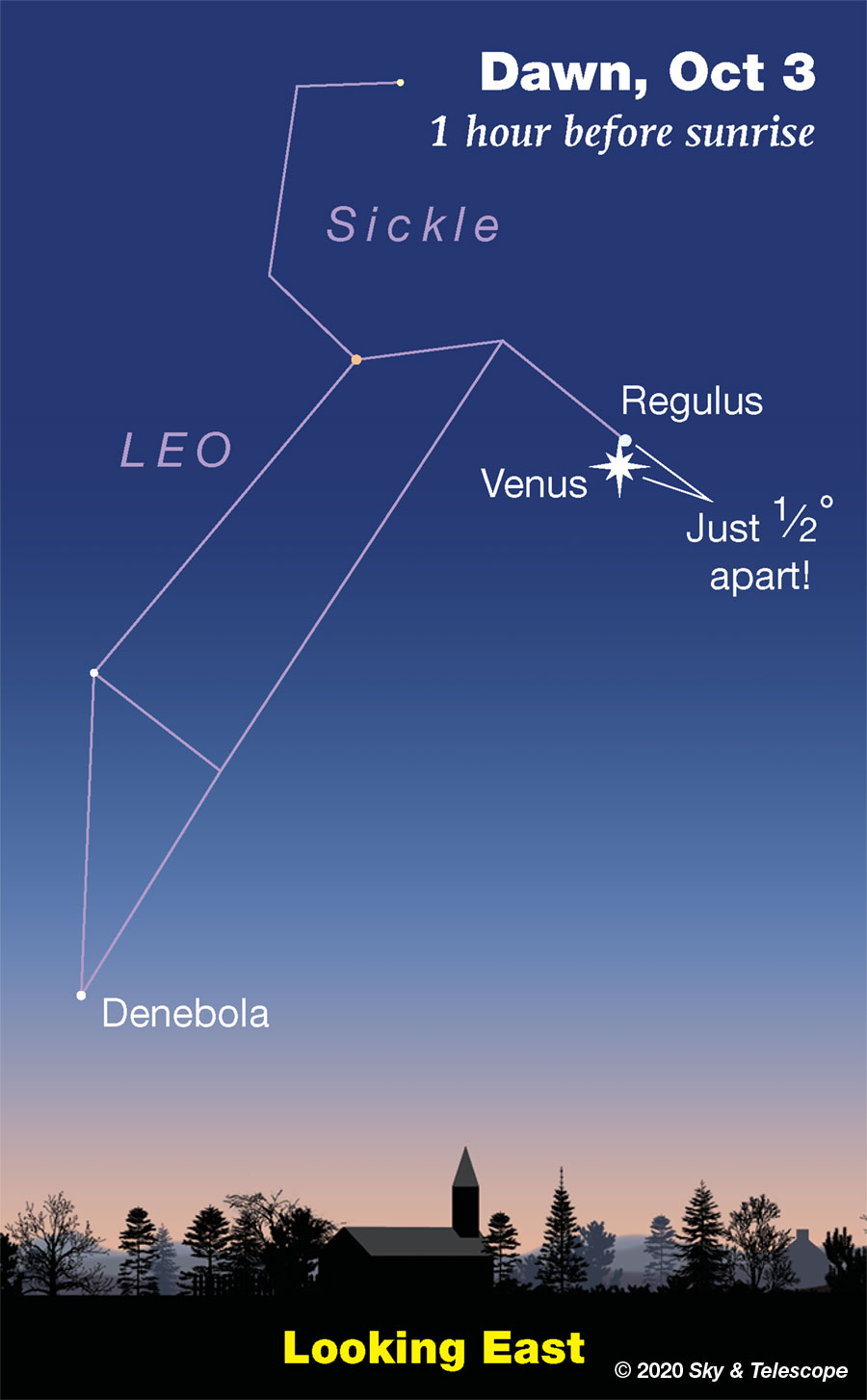
FRIDAY, OCTOBER 2
■ Moon and Mars. The Moon, a day past full, rises in mid-twilight with bright Mars by its side! After dark they make a striking pair, only 1° or 2° apart for North Americans. Think photo opportunity. The Moon will occult Mars for parts of southern South America; map and details.
Later in the night, watch them draw farther apart. Although they look like companions, Mars is 155 times farther away tonight. And although Mars looks tiny, it's twice the Moon's diameter.
■ Before dawn Saturday morning Venus and Regulus are again 0.6° apart, but now Regulus is on top, as shown above.
SATURDAY, OCTOBER 3
■ Now the Moon rises near the end of twilight, with Mars blazing brightly about a fist at arm's length to its upper right.
■ With fall well under way, Algol is well up in the northeast after dark. Normally it shines at magnitude 2.1, but this evening it has one of its periodic self-eclipses: It should be as faint as magnitude 3.4 for a couple hours centered on 9:48 p.m. EDT. Algol takes several additional hours to fade and to rebrighten.
Compare it to Gamma Andromedae, magnitude 2.1, about a fist to its upper right. And see Bob King's When Algol Winks, Will You Wink Back?
This Week's Planet Roundup
Mercury is still in a very low, poor apparition deep in the sunset. At least it's fairly bright at magnitude 0.0 this week, so go ahead and try. Bring binoculars at least. About 15 minutes after sunset while twilight is still bright, scan for Mercury just above the west-southwest horizon. Good luck.
Venus (magnitude –4.1, in Leo) rises in deep darkness almost two hours before dawn begins, in the east-northeast. By the time dawn gets under way, Venus shines prominently in the east, as shown below.
While the sky is still dark, spot Regulus below Venus or to its lower left, as shown below for September 26th. Regulus is less than 1% as bright. Watch them close in on each other morning by morning for the rest of the week. They'll about ½° apart on the mornings of October 2nd and 3rd.
Taking a much wider view, Procyon shines high to Venus's upper right (by three or four fists at arm's length). To the lower right of Procyon, by two or three fists, lies effulgent Sirius — the brightest star in the sky but no match for Venus.
In a telescope, Venus continues to shrink slowly into the distance; it's now only 16 arcseconds in diameter. And it's growing more gibbous, 70% sunlit, as it rounds toward passing behind the Sun next winter.
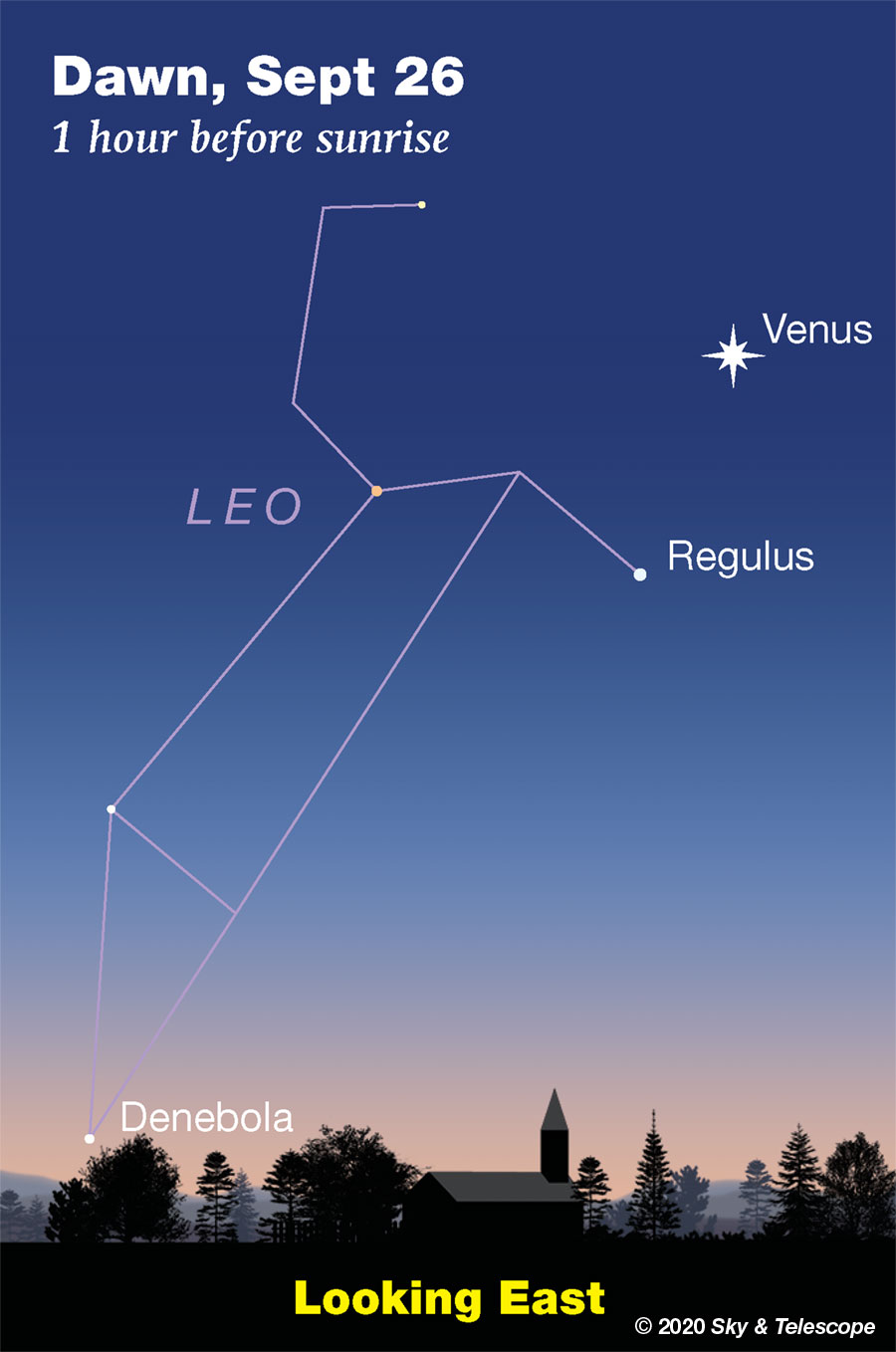
Mars shines big, bright, and close as it nears its October 13th opposition! This week it rises in twilight. After dark it glares orange low in the east, as bright as Jupiter at magnitude –2.4 but yellow-orange to Jupiter's creamy white. Mars climbs higher through the evening and stands at its highest and telescopic best around 2 a.m. daylight-saving time, beaming down from Pisces high in the south.
Mars passes closest to Earth on October 6th, a week before opposition, but it's already as big and close as it will get for all practical purposes (22.0 to 22.3 arcseconds wide this week; 22.6 when closest). We're already getting the best view of Mars we'll have until July 2033! To see a map of the side of Mars facing Earth at the date and time you'll observe, try our Mars Profiler. The map there is square; remember to mentally wrap it onto the side of a globe. (Features near the map's edges become very foreshortened.)
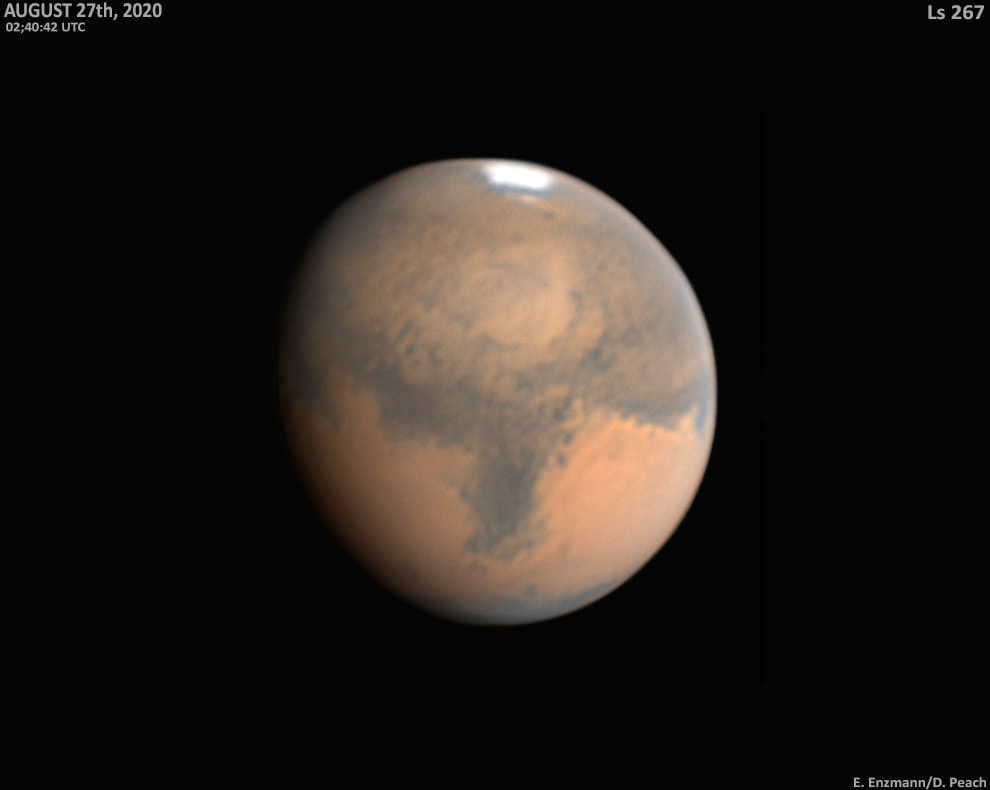
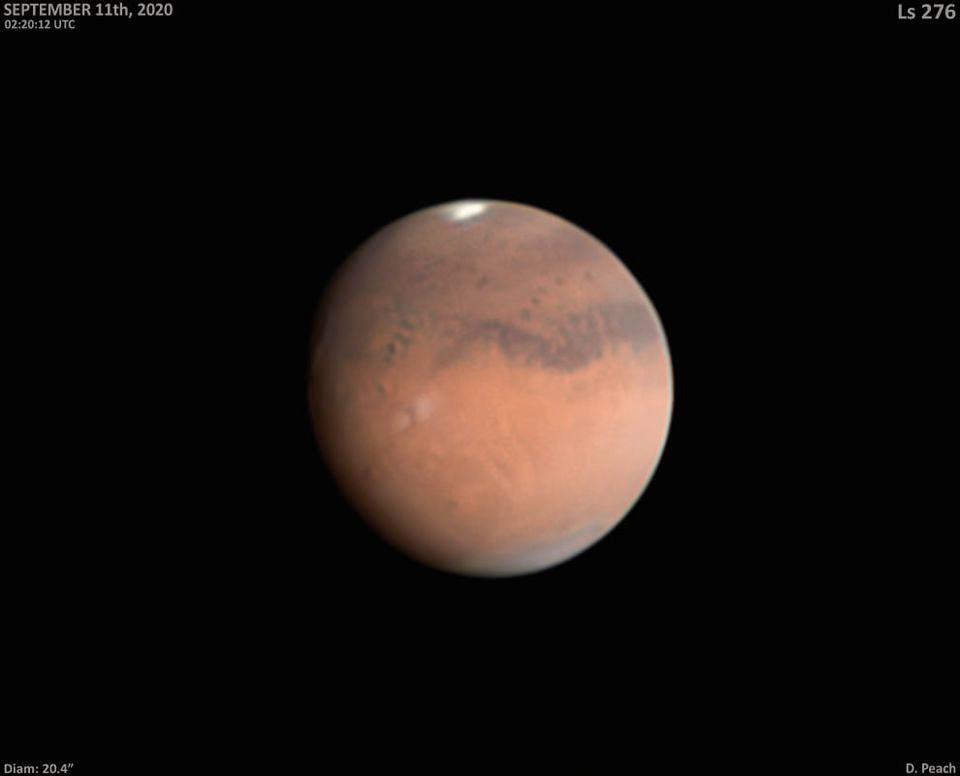
Jupiter and Saturn (magnitudes –2.4 and +0.5, respectively) shine in the south during dusk and early evening, as shown at the top of this page, then move to the southwest as evening grows late. Jupiter is the brightest. Saturn is 7½° to its left. Watch the two planets gradually edge together for the rest of the fall. They will pass just 0.1° from each other at conjunction on December 21st, low in twilight, just as fall turns to winter.
Very high above them shines Altair, magnitude +0.8. It's white-hot, 11 times as luminous as the Sun, and just 17 light-years away.
Much closer below Jupiter after dark is the handle of the Sagittarius Teapot. The brightest star of the handle (the upper-right one) is Sigma Sagittarii or Nunki, magnitude 2.0. It's an even larger, hotter blue-white star: 4.5 times the diameter of the Sun, 3300 times as luminous, and 230 light-years away.
Telescopically there's a lot happening on Jupiter now; see Bob King's Stormy Times on Jupiter. And you can follow the interplay of Jupiter with its moons and their shadows, and find the transit times of Jupiter's Great Red Spot, in the Celestial Calendar section of the current Sky & Telescope.
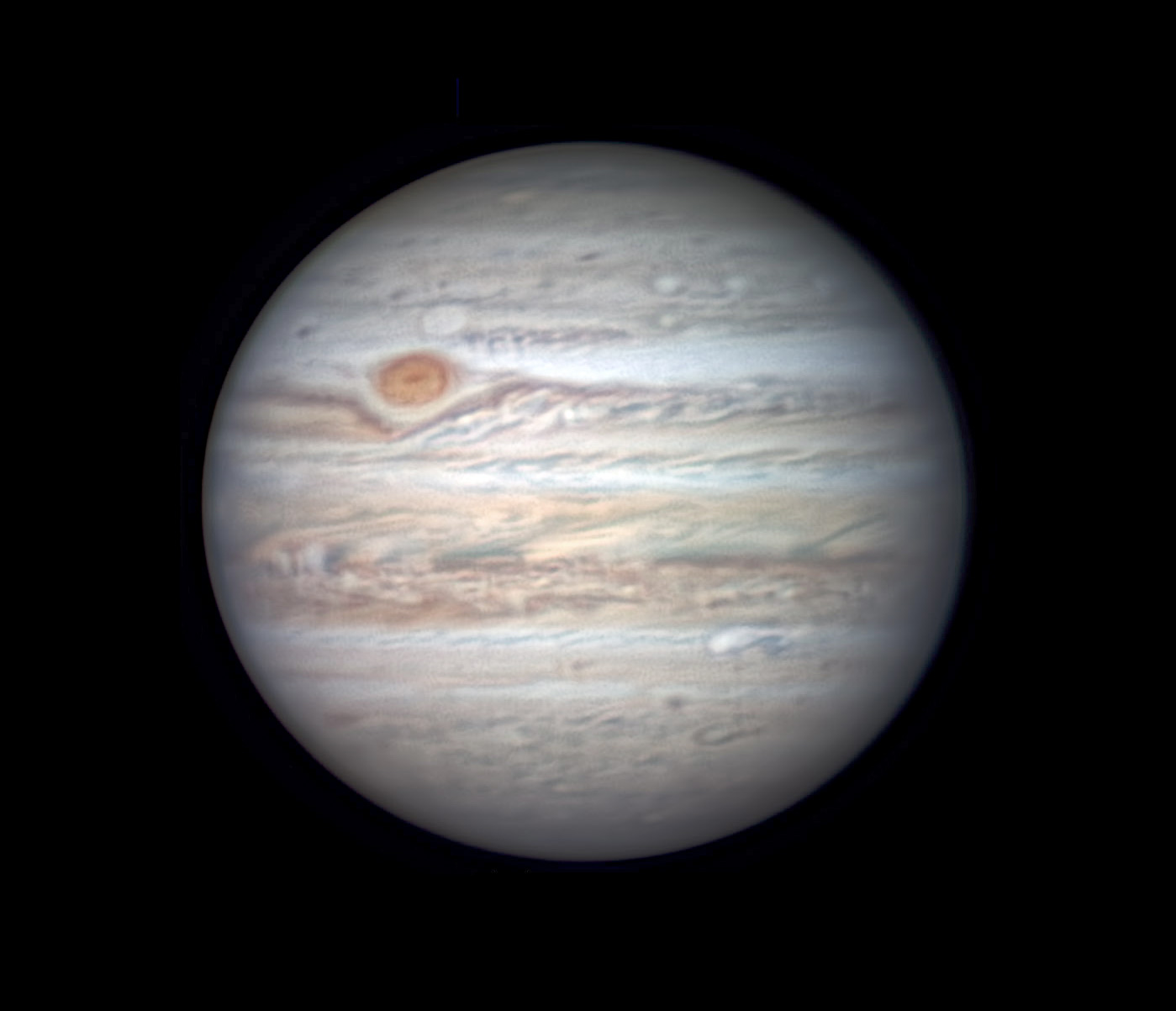
Skilled, well-equipped amateurs like Go can capture extraordinary planetary detail by judicious use of video-image stacking and processing. For comparison, here is a Hubble image of Jupiter taken two days later showing nearly the same face (full-res version), with the contrast and color contrast boosted way up for looks. The Hubble is a fantastically sophisticated 92-inch telescope above the atmosphere in bare vacuum. Go, who lives in Cebu City, Philippines, uses a commercial 14-inch Schmidt-Cassegrain telescope on his apartment balcony!
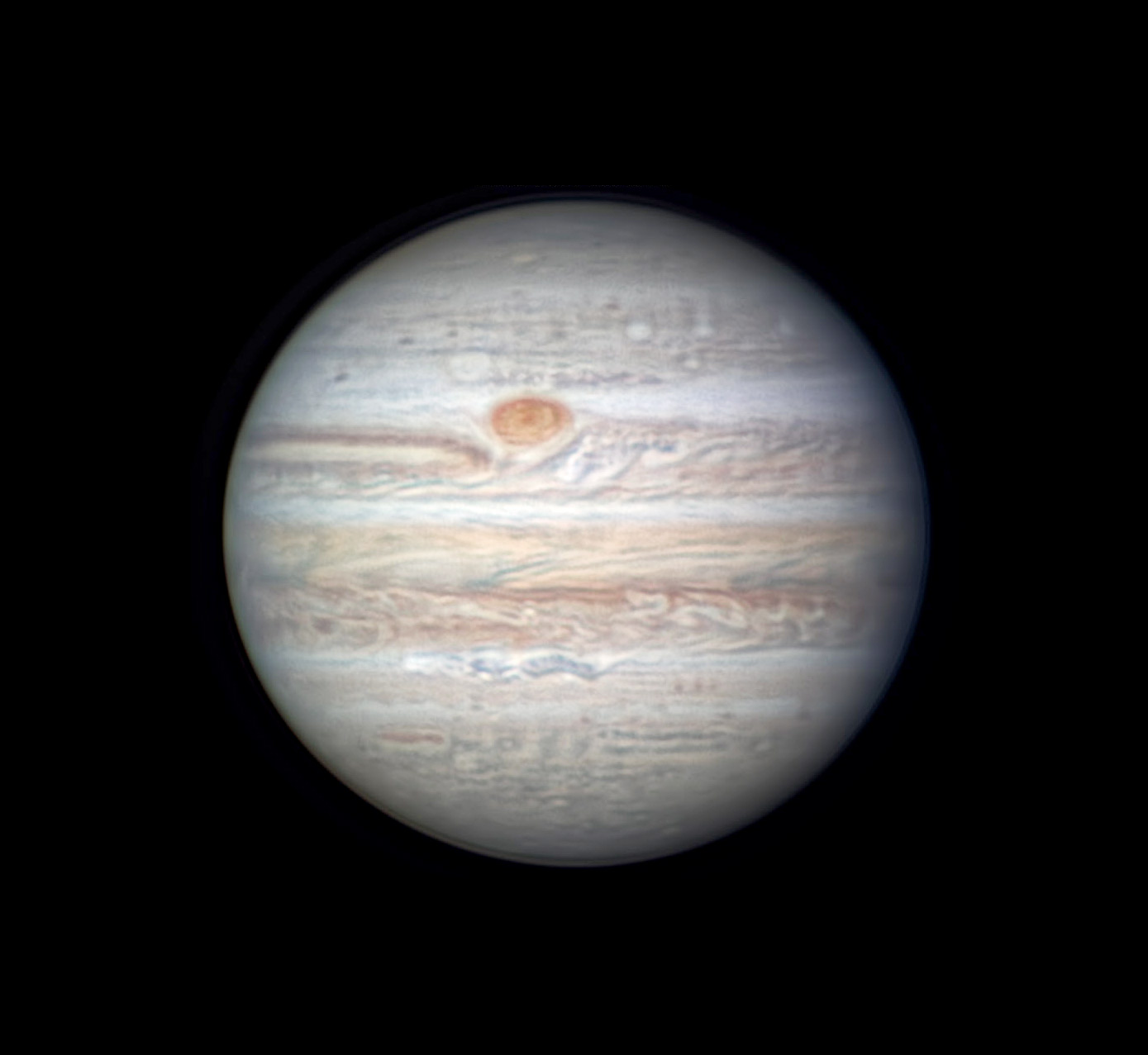
Uranus (magnitude 5.7, in Aries) is fairly well up in the east by 10 or 11 p.m. daylight-saving time, about 15° east of Mars. Uranus is only 3.7 arcseconds wide, but that's enough to appear as a tiny fuzzy ball, not a point, at high power in even a small telescope.
Neptune (magnitude 7.8, in Aquarius) is higher in the south-southeast at that time. Neptune is 2.4 arcseconds wide, harder to resolve except in good seeing. Finder charts for Uranus and Neptune.
All descriptions that relate to your horizon — including the words up, down, right, and left — are written for the world's mid-northern latitudes. Descriptions that also depend on longitude (mainly Moon positions) are for North America.
Eastern Daylight Time, EDT, is Universal Time minus 4 hours. (Universal Time is also known as UT, UTC, GMT, or Z time.)
Want to become a better astronomer? Learn your way around the constellations. They're the key to locating everything fainter and deeper to hunt with binoculars or a telescope.
This is an outdoor nature hobby. For an easy-to-use constellation guide covering the whole evening sky, use the big monthly map in the center of each issue of Sky & Telescope, the essential magazine of astronomy.
Once you get a telescope, to put it to good use you'll need a detailed, large-scale sky atlas (set of charts). The basic standard is the Pocket Sky Atlas (in either the original or Jumbo Edition), which shows stars to magnitude 7.6.

Next up is the larger and deeper Sky Atlas 2000.0, plotting stars to magnitude 8.5; nearly three times as many. The next up, once you know your way around, are the even larger Interstellarum atlas (stars to magnitude 9.5) or Uranometria 2000.0 (stars to magnitude 9.75). And be sure to read how to use sky charts with a telescope.
You'll also want a good deep-sky guidebook, such as Sky Atlas 2000.0 Companion by Strong and Sinnott, or the bigger (and illustrated) Night Sky Observer's Guide by Kepple and Sanner.
Can a computerized telescope replace charts? Not for beginners, I don't think, and not on mounts and tripods that are less than top-quality mechanically, meaning heavy and expensive. And as Terence Dickinson and Alan Dyer say in their Backyard Astronomer's Guide, "A full appreciation of the universe cannot come without developing the skills to find things in the sky and understanding how the sky works. This knowledge comes only by spending time under the stars with star maps in hand."
![]() Audio sky tour. Out under the evening sky with your
Audio sky tour. Out under the evening sky with your
earbuds in place, listen to Kelly Beatty's monthly
podcast tour of the heavens above. It's free.
"The dangers of not thinking clearly are much greater now than ever before. It's not that there's something new in our way of thinking, it's that credulous and confused thinking can be much more lethal in ways it was never before."
— Carl Sagan, 1996
"Facts are stubborn things."
— John Adams, 1770
 4
4








Comments
Rod
September 25, 2020 at 9:21 am
mary beth, New Jersey Eclipse Fan et al. The report shows a close conjunction of Venus and Regulus early morning 01-Oct. "Before dawn on Friday morning, look east. Venus and Regulus are only 0.6° apart. Regulus, below or lower left of Venus, is less that a hundredth as bright." I plan to try and view this using my 90-mm refractor telescope. On 21-Sep, I enjoyed some very good views of Venus that morning. Note from my stargazing log: "Observed 0500-0600 EDT/0900 - 1000 UT. Sunrise at 0654 EDT/1054 UT. Excellent views of Venus this morning using 14-mm Delos, 1.8x Barlow lens, and 9-mm Nagler. 71x to 200x views. Celestron #38 Blue filter, #12 Yellow filter, and #58 Green filter used. Very nice views using #58 Green filter, possible hint of some cloud bands near equator and center. The star Pi Cancri and asterism visible in FOV at 71x. Good position fix of Venus in Cancer this morning. Venus 68% illuminated so easy planetary and gibbous shape distinct."
You must be logged in to post a comment.
New Jersey Eclipse Fan
September 25, 2020 at 5:55 pm
Looking forward to your report. Here's hoping for clear skies!
You must be logged in to post a comment.
Rod
September 26, 2020 at 11:08 am
I will try New Jersey Eclipe Fan. Venus is zipping along the ecliptic, rapidly changing its position relative to the *fixed stars*. When I viewed Venus early morning on 21-Sep, it was close to Pi Cancri star. When Venus is near Regulus, some 13 degrees or more of angular change in its position takes place. Pi Cancri and Regulus are about 13 degrees 15 arcminute apart. Watching these planetary changes with a good telescope, you can see the heliocentric solar system in action 🙂
You must be logged in to post a comment.
mary beth
September 26, 2020 at 11:06 pm
Hi Rod! The true calendar! Sounds like you’ve had a very nice week. Great weather on tap here. Got to see Mars at a reasonable time last night and it was stunning! Arcturus was twinklIng beautifully in the northwest getting ready for its spooky role as ‘ghost of the summer suns’ late next month. I get a real kick out of the fun little descriptions on S&T.
NJEF -how is the stargazing there? i’m curious if you will be able to see Canopus this winter or whether you are too far north.
You must be logged in to post a comment.
You must be logged in to post a comment.